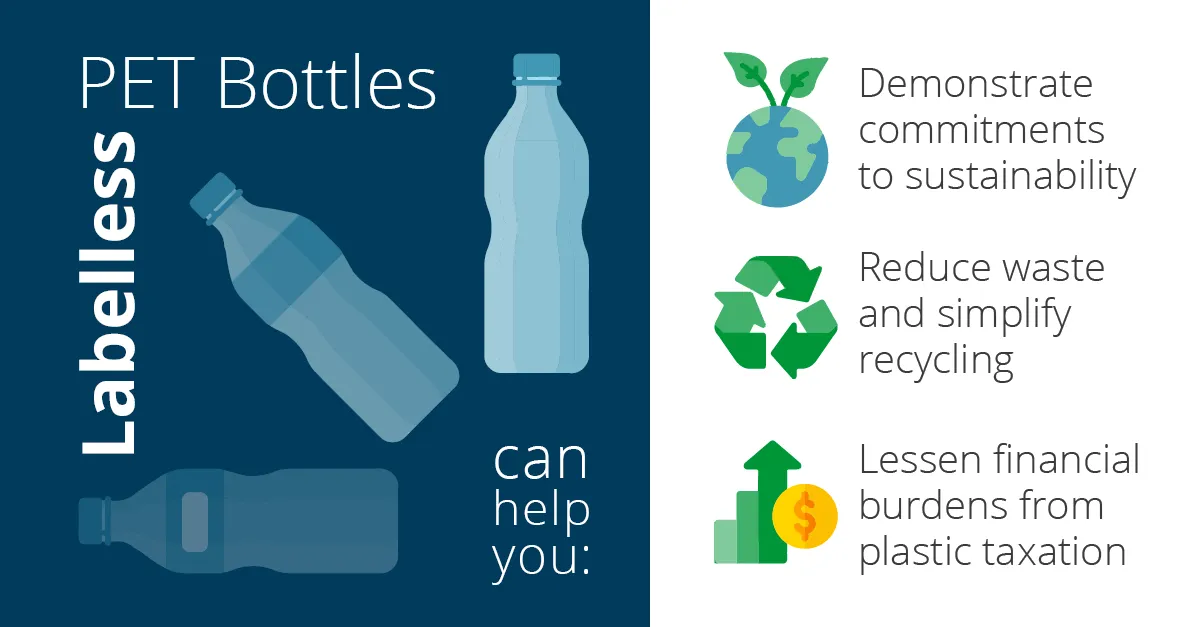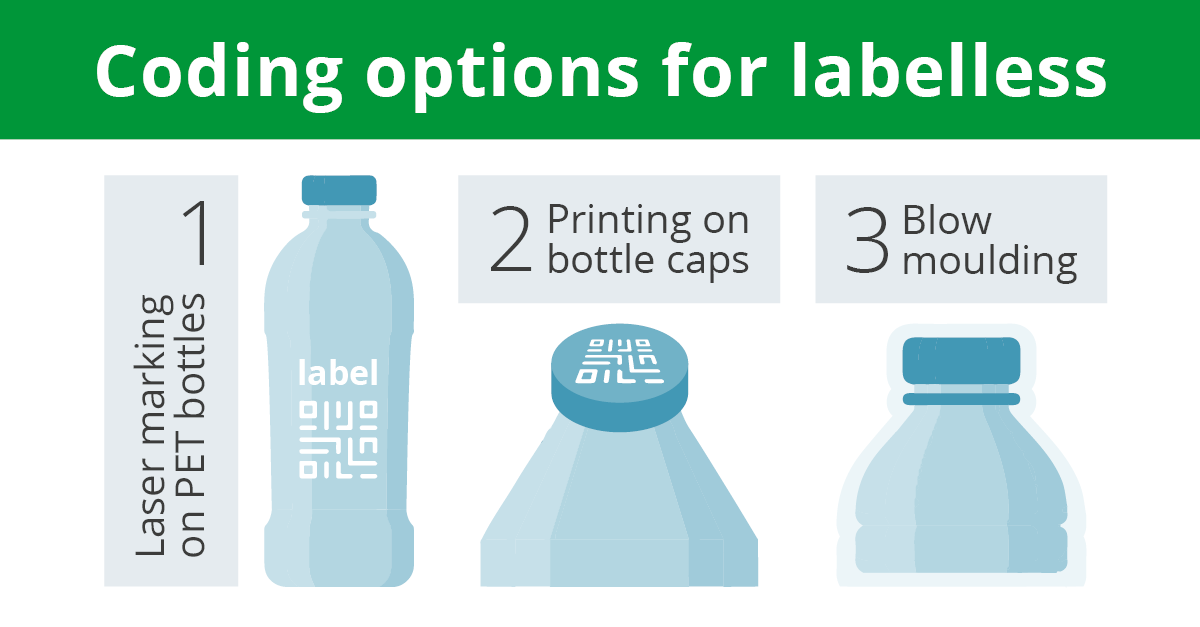Introduction
Packaging should be simplified to help improve recyclability. Using easily recycled mono materials, removing colours and additives, and reducing the number of parts in a piece of packaging are all ways that brands can look to improve recyclability.
But what if a vital part of the product packaging caused recycling issues? Such is the case with external labels or shrink sleeves on bottles, which provide crucial product information but can provide significant recycling challenges.
In this blog, we will look at the growing trend of labelless or label-free PET beverage bottles and highlight some options available for brands looking to move away from external labels while still adhering to the necessary product marking requirements. Read on to find out more.
What is a labelless bottle?
Labelless or label-free bottles are produced from a single piece of material, such as plastic or glass, without an additional external label or sleeve. Such products are growing in popularity for widely recycled packaging products, such as PET bottles, where the addition of an outer plastic label can cause issues with recyclability.
Worldwide, PET is the most recycled plastic, with recycling rates exceeding 50% in certain regions, including India, Europe, and South Korea[i], but there is still a lot that can be done to improve this figure. Removing labels from PET bottles is one such step.
Not only are labels often not recyclable – creating additional plastic waste and necessitating removal either prior to collection or as part of the recycling process – but they can cause issues with the identification of bottles in recycling facilities. Labels may be made from plastics other than PET – including polyethylene or polypropylene – and, as many recycling facilities use machine optics to identify different materials, using alternative plastic labels can cause PET bottles to be incorrectly identified.
Increasing PET recycling rates
The trend for labelless or label-free PET bottles is now being explored with interest in the beverage industry, as governments worldwide explore projects to increase PET recycling rates and improve the quality of recycled materials.
In December 2020 the Ministry of Environment of the Government of South Korea launched a campaign to promote kerbside disposal of transparent PET bottles, alongside new legislation which will prohibit the use of external labels on bottled water from January 2026[ii]. Ten major Korean mineral water producers subsequently signed agreements to release new product lines using labelless transparent PET bottles to improve the quality of recycled materials. In October 2021, The Coca-Cola Company released its first labelless water South Korea, with label-free bottles sold online in packs of 24[iii].
The government of Japan has set out a plan to move towards the utilisation of 100% recycled plastic packaging by 2035. Japan has relatively strict rules for recycling plastic – consumers must separate PET bottles from their labels and caps. Labelless PET bottles would make the process easier for consumers, and several of Japan’s key beverage companies are starting to promote labelless packaging in their core brands.
In the EU, Directive 2019/904 requires mandatory tethered bottle caps for plastic bottles by 3 July 2024 and stipulates that PET drinks bottles must contain 25% recycled plastic from 2025 and 30% from 2030. Increasing the quality and quantity of recycled PET is imperative to meet these targets.
What are the advantages of labelless PET bottles?

Ease of recycling: Labelless or label-free PET bottles are easier to recycle than bottles with an external label. Consumers are not expected to remove or dispose of plastic labels separately, and recycling infrastructure doesn’t need to facilitate label removal. In addition, there is less risk of bottles being incorrectly identified.
Waste reduction: Removing external labels from PET bottles has the potential to reduce plastic waste dramatically. In fact, the Ministry of Environment of the Government of South Korea reported that removing all labels from plastic water bottles could save the country 24.6 million tonnes of plastic waste per year, based on the sale of 4.2 billion bottled water products in 2019.[iv]
Fewer penalties for manufacturers: Labelless PET bottles can also reduce the financial burden for manufacturers in regions with plastic taxation. For example, in the UK, items of single-use plastic packaging that contain less than 30% recycled content are taxed at £200 per tonne. While PET bottles can easily incorporate above 30% recycled content, labels and caps – which do not typically contain recycled material – are taxed separately. Tesco supermarket in the UK recently reported that plastic taxation for labels accounts for approximately 10% of the total annual plastics tax liability for one prominent own-brand beverage line[v].
However, labelless packaging can come with complications in ensuring that an item adheres to regulatory labelling requirements and displays the proper information for consumer understanding. As such, the move to labelless or label-free bottles necessitates innovative new methods of coding and marking bottles.
What coding options are available for brands producing labelless bottles?

The appropriate coding and printing solutions for labelless or label-free PET bottles will depend on a number of different factors, including regional labelling requirements and whether the bottles will be sold as part of a multipack or individually.
For multipack bottles, it may be possible to include compulsory labelling requirements as part of the secondary packaging, removing the need for coding on individual bottles. There are several potential solutions for bottles sold individually, which we will explore in the sections below.
Laser marking on PET bottles
Laser coders can be used to code on the body of PET bottles and provide product data such as nutritional information, composition data, batch codes, barcodes, recycling logos, and other graphics and text.
The type of laser used will be dependent on individual brands parameters, including:
- The bottled beverage type: water and clear liquids will require a coding solution capable of achieving a darker contrast than dark-coloured liquids such as colas and other soft drinks.
- The thickness of the PET: the wall thickness requirement for still water is typically much less than that of carbonated beverages and soft drinks. This can limit the suitability of certain lasers to code effectively without compromising bottle integrity.
- The percentage of recycled PET: slight impurities in recycled PET can impact plastics’ ability to absorb the wavelength of certain laser types and affect code quality.
Printing on bottle caps
Brands can also choose to print directly on bottle caps. The small size of bottle caps will limit how much data can be printed; however they are typically well suited for simple product branding and logos. They can also accommodate machine-readable codes, including scannable 2D Codes, to provide additional product information, traceability data, and promotional material.
The ideal solution for printing on bottle caps will again be dependent on individual brand specifications, including:
- Cap material: different inks and lasers are suited to different plastic types, so cap material will ultimately affect technology choice.
- Colour of the bottle cap: the required contrast between the cap and the code will affect ink choice and suitability of different lasers.
- Code requirement: linear barcodes and scannable 2D codes will require a high-resolution ink or laser coding solution.
- The stage at which the caps will be coded: it’s relatively simple to code loose caps, but this may not be a suitable solution for all production lines. Lines requiring cap coding of bottles post-fill will require a product handling solution to ensure quality coding.
Branded blow moulding
A key concern for brands exploring labelless or label-free bottles will be how to manage branding to ensure that products and packaging are easily recognised and in keeping with brand identity.
It is possible to incorporate branding such as logos and text via on-pack laser coding or directly onto bottle caps. Another alternative would be to incorporate branded shapes and logos into the bottle design via blow moulding. In 2022, Amcor Rigid Packaging and Danone adopted blow-moulded labelling when creating a new, 100% recycled, labelless bottle for the Villavicencio water brand in Argentina.
Labelling systems for labelless bottles: what you need to know
When choosing a technology for marking labelless or label-free PET bottles, no solution is available to suit all brands. The optimal solution may be bespoke, developed to suit specific requirements, and depend on various factors, including those explored above.
Brands looking to introduce labelless beverage options due to regulatory requirements or as a reflection of commitments to sustainability should discuss requirements with their coding and marking partner to determine the right solution.
Domino is currently working with several leading beverage brands to develop bespoke solutions for labelless bottles and is available to offer advice and product sampling for any brand looking to explore this area.
If labelless PET bottles are something you are considering for the future, or if you would like to learn more about what a labelless coding solution might look like for your company, please get in touch.
[i] https://www.plasticsforchange.org/blog/which-plastic-can-be-recycled
[ii] http://www.me.go.kr/home/web/board/read.do?boardMasterId=1&boardId=1415490&menuId=286
[iii] https://www.koreaherald.com/view.php?ud=20211025000808
[iv] https://www.koreatimes.co.kr/www/nation/2021/06/371_308273.html
[v] Paul Earnshaw, Tesco, Sustainability in Packaging, Sustainability in Packaging Europe, 2nd November 2022.